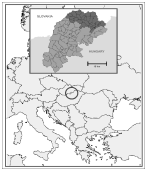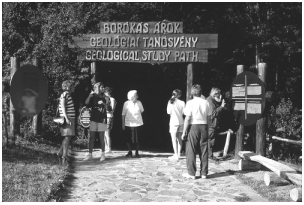Dr. Janos Tardy1,Imre Szarvas2
Keywords: trans-boundary geopark, Neogene, heritage, geotourism, Slovakia, Hungary, environmental protection
Poster presentationabstract,topic number 2

The creation of theNovohrad-Nograd Geopark is an ongoing transborderproject between Slovakia and Hungary. It has been initiated by local subregions, supported bymunicipalities, NGOs andterritorial agencies alike.
This grassroots movement has been building on the rich geological heritage of the area. Diverse marine and terrestrial sediments and varied volcanic rocks and forms represent the Neogene and Quaternary. The area’s harsh history created a unique landscape: morphology with rolling hills and volcanic plateaus,lowlands with overtowering peaks of volcanic dikes.
The peaks were occupied by fortresses during the middle ages and in the hidden valleys isolated communities maintained their special folklore, the human landscape is interwoven on several level with the geological past.

The logo of the geopark symbolizes Somoskő castle, which was built atop columnar basalt. At the very foot of the fortress was drawn the border line between Slovakia and Hungary after the First World War, separating communities from each other and artificially dividinglandscape for 85 years.
The region is enriched by specialanimate assets as well. Due to the mosaic-like habitats, several protected sites are within its confines on both sides of the border. But the localswere notreally involved in preserving the natural heritage of their surroundings, they were not aware of the area’s uniqueness and they saw only control and restrictions, not the potentials for making a living by maintaining its condition.
The Bükk National Park Directorate(Hungary) and the Cerova Vrchovina Protected Landscape Area(Slovakia) as prime regional nature conservation authoritieshave realized that the best way to move forward in the field of nature protection is to endorse the geopark initiative. When sustainable geotourismcan provide tools for the economic development of the region, then the locals have a stake in the protection of their environment.
150 thousand hectares and 140 thousand people are within the confines of the prospective Novohrad-Nograd Geopark.
The would-be geopark has good capabilities for geotourism, several of its geosites already have self-guided trails, it has an underground mining museum and its most famous geosite, the European Diploma-holdingIpolytarnóc Fossils Nature Conservation Area has been running guided tours on its geological trail since 1986.

There is an ongoing development project on the Fossil Area, its800 meter-longtrail -- with its protective halls -- has been made accessible for handicaps this year and the Visitor Centre is still under construction to provide comprehensive facilities for the interpretation of the site’s geological past. The trail itself is a key section. It spans the Lower-Miocene fossilliferous strata from the sharkteeth-bearing marine sandstone till the volcanic deposits, that buried a rainforest and preserved thousands of animal traces 20 million years ago.
Beside thegeological heritage, the geopark is rich in other already recognized naturaland cultural assets as well, for example the Ancient Village of Hollókő ( World Heritage Site) is within the confines of the planned geopark.
By linking these attractions in an effective network, sustainable tourism can be reached.
To achieve this, the creation of the geopark database has started this year, the Hungarian Geological Society is the leading partner in it, with strong local involvement.
A geopark is a holistic entity of recognized capabilities and realities, it hosts the interweaving networks of living communities within itself, where the interdependent coexistence of natural environment and its active transformer, the human society must strengthen each other.
The Novohrad - Nograd Geopark initiative wants to build on this recognition, to reunite people and landscape again!
Epilogue:
It is not easy to explain to the would-be stakeholders, what is new in the geopark idea. Some of the decision makers consider the geopark as a kind of subcategory of nature parks and think it an unnecessary distinction. Laymen think it as an indication of new restrictions and that is why they are against, afraid of it. Outreach is essential, part of it is interpretation, in which leaning upon only pure science without spirituality, would surely lose the battle.
So how can we address the human mind?
The geopark - as a metaphor - is a tree of a grove. The trunk of it is the geological past, the surfaced manifestation of the prehistoric Earth, from which as branches spread outthe diversity of our present time. Within its crown coexist the humanlandscape with organic farming of nature parks andthe treasures of hidden corners ofnational parks and other protected areas. But some branches of it represent thecultural achievements of humanity, churches, historic memorials, the colourful whirl of folklore and recreation opportunities as well.
A geopark tree is part of a grove, it is a social creature. When it was born, was not alone, even in its birth it constituted a network, since the European Geoparks Network was founded by4 sister members. ( Even this fact shows that the geopark idea is very unique, since in its appearance it became - not as for example in the case ofnational parks, where the Yellowstone National Park was born alone in1872 - part of a community. )
This is it, the geopark tree is part of a grove, and if those groves could mergeinto a network offorest, we will leave to our descendants a better world behind."
-------------------------------------------------------------------------------------------------------------------------------------------------------------------------------
1 former deputy secretary of state, co-president of the Environment Protection Committee of the Hungarian Academy of Sciences, vice president of ECNC (jtardy@t-online.hu),2 Bükk National Park Directorate (itarnoc@t-online.hu)